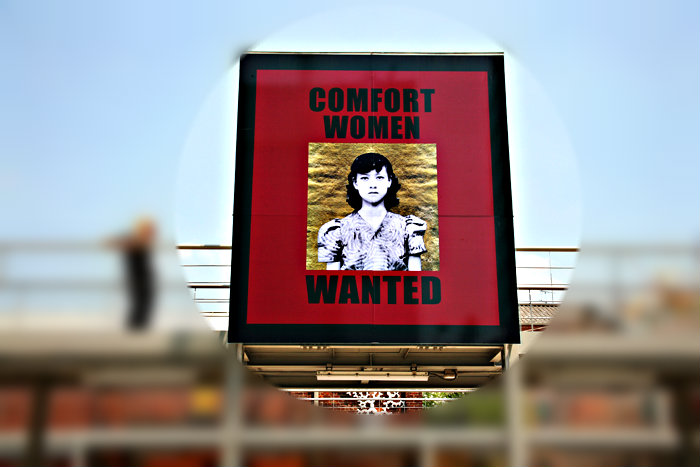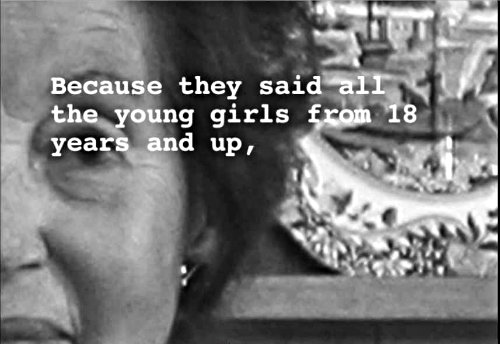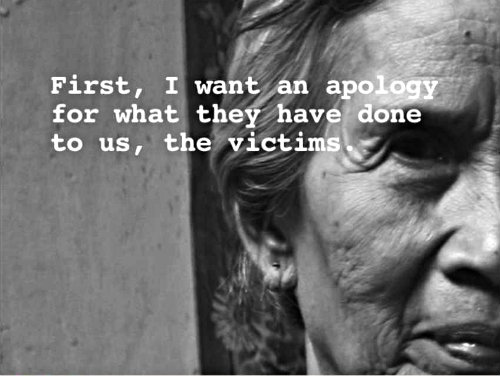“Comfort Women Wanted”, the exhibit that focuses entirely on the lives and experiences of World War Two sex slaves — a history the artist of the exhibit fears will go forgotten.
New York artist Chang-Jin Lee read about the experiences of about 200,000 women and girls forces to be sex slaves of the Japanese Imperial Army during the Second World War in a New York Times article way back in 2007 and it was then that she decided to do something about it.
“Comfort Women Wanted” is the fruit of that decision.
Lee, born from Seoul, South Korea, traveled four times to seven countries between the years 2008 to 2012 to meet up with WWII sex slavery survivors, gather images and take photographs of them and from these works she produced various exhibitions shown across the US and other countries in the past three years.
“Comfort Women Wanted” is her latest exhibit and features seven compelling panels which showed survivors in their young age along with two videos which contain photos, interviews and folk songs. The display is currently on view at the Charles B. Wang Center which is located at Stony Brook University.
Lee’s inspiration for her current exhibit’s title was the headline found in the newspaper adverts which were intended to lure women and girls to work as prostitutes for the soldiers of the Japanese Imperial Army.
According to Lee, these adverts didn’t work well as expected. However, she did accede that there were a few who got paid for working as “comfort women” in the beginning. The rest of the WWII sex slavery victims were either kidnapped or were bamboozled with job offers of works that didn’t really exist. In the end, these women were brought to the “comfort stations” – an array of huts or rooms found in the industrial complexes set up in Japan and its occupied territories – and were raped for up to 100 times in a day by one soldier after another.
A Soldier’s Apology
In one of Lee’s videos, a former Japanese WWII soldier described the conditions of these “comfort women” in those times. This soldier was one of the only two who came out in the public, acknowledged and actually apologized for the practice during the WWII-era.
![[Photo: From the "Comfort Women Wanted" Exhibit]](https://www.warhistoryonline.com/wp-content/uploads/sites/64/2015/01/Comfort-Women-Wanted-Image-I.jpg)
The video showing lee’s interview with him runs contemporaneously with a longer one which featured interviews from some of the WWII sex slavery survivors.
The Survivors’ Stories
Central to the “Comfort Women Wanted” exhibit are the testimonies given by actual surviving “comfort women”.
One such is Emah Kastima who is from Indonesia and was kidnapped from a market when she was just 17. In voice that’s just above a whisper, she described the ordeal she went through as a WWII sex slave saying that some soldiers beat her and that she hated every moment of being treated in that way.
Jan Ruff O’Herne, who, according to Lee was the first woman of European descent to come out, recounted how she was selected by the Japanese at the age of 21 while she was interred in a Japanese prison camp. She had been in that camp for over three years. She added that nine other young women were chosen and hauled away with her much to the dismay and cry of their families.
Still, another comfort woman, Lee Yong Soo from Korea, strongly said that if ever she was born again in those times, she hoped to be born a woman soldier.
The Installation
Lee put up her exhibit with simultaneous videos saying that the dissonance created by the battling sounds of the pictures is intentional as it is meant to draw an intentional response from the viewers.
Furthermore, the “Comfort Women Wanted” exhibit acts as a reflection on a still very sensitive issue even after almost seven decades from when WWII ended.
Although Japan has already issued a an apology about it way back in 1993, the country’s current government maintains that the women were not coerced into working in the brothels. Nevertheless, majority of the scholars as well as many nations believe the testimonies given by survivors which, according to Lee, just constitute about 25 to 30% of the women who suffered through the ordeal.
Nonetheless, the curator of the exhibit and the associate director of cultural programs at the Wang Center, Jinyoung Jin, points out that Lee’s exhibit doesn’t finger point at anyone. In fact, she said, it highlights an ongoing struggle in our society today — that is the continuing problem of global human trafficking.
According to Jin, the “Comfort Women Wanted” is more than a documentary; it presents the stories in a caring way and gives voice to women who, in their days, didn’t have strong voices in the society. She added that the display had brought out strong responses from its viewers and is a benefit for those who study art and history.
Besides, as Logan Marks, a fine arts master’s student at Stony Brook University and one of the show’s installers, denotes, the location of the exhibit plays a significant role in its being. The “Comfort Women Wanted” show is in the building’s lowest level, meaning, its surroundings lend a dark feel to it. Being a heavy-duty subject, Marks said, a person visiting the show will surely be moved and affected by it.
Behind “Comfort Women Wanted”
Lee used the support given to her from a number of grants and fellowships to travel to Japan, Taiwan and Korea in 2008, Indonesia and China in 2010, Australia in 2011 and the Philippines in 2012 to gather the information, photos and videos she needed for her exhibits. Her video presents seven different languages.
She, then, used photos given to her by the women in their younger days – may it be before their enslavement, during and even after – for the exhibit’s larger prints. As she wanted a bigger impact on the minds of the viewers, something that will carve the images to memory, she made each print over five feet tall.
Made after the Japanese adverts used during the WWII, the photos are placed on the center of each print and are framed in black and red with the words “Comfort Women Wanted” boldly emblazoned in front. The phrase is printed in four languages – English, Korean, Chinese and Filipino. To make the prints more arresting, though, Lee used gold as the background of the pictures describing it like a “saint’s halo in a painting from the Renaissance”.
Among her prints, Lee find that of a Taiwanese comfort woman most moving. Mei Chen’s photo was taken by a Japanese soldier and showed her unsmiling. According to Lee, the photo of the young lady looked like she was not there, like she was detached from it all. According to her, escapism had been one of the ways the comfort women of WWII adapted to be able to cope up with the conditions they were in.
“Comfort Women Wanted” is still ongoing until January 10, 2015. For those interested to visit the exhibit, just go to the Zodiac Lobby Gallery, Charles B. Wang Center, Stony Brook University or visit this website – www.stonybrook.edu – for more information.
https://www.youtube.com/watch?v=1IeFXOjgj4A


